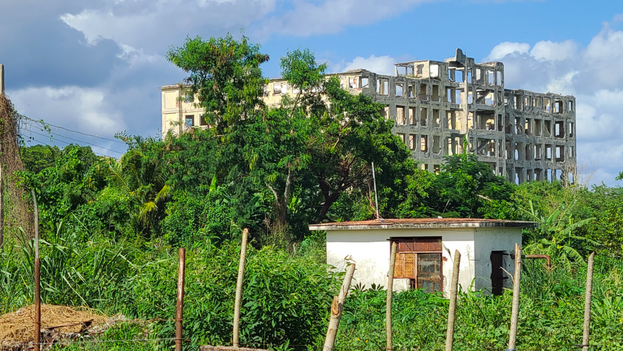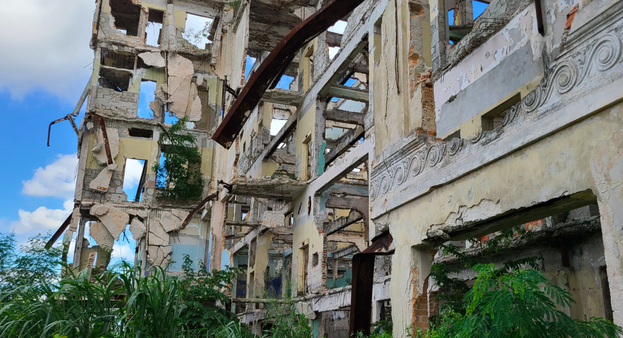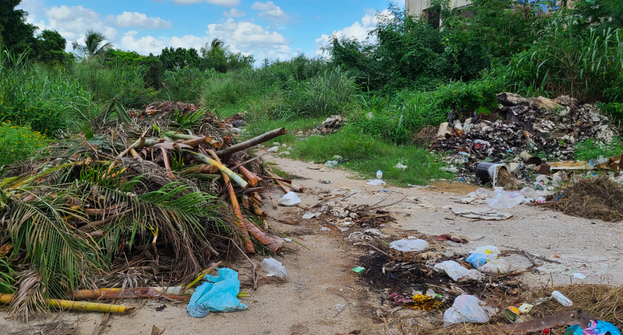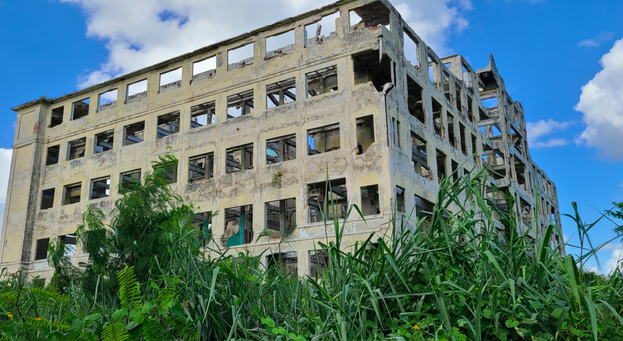
![]() 14ymedio, Nelson García, Havana, October 19, 2023 — Cuba’s ruins have one thing in common: slogans with large letters painted on pieces of walls. In the case of the old Lebredo maternity hospital, located in the Havana municipality of Arroyo Naranjo, the message – a dig at former U.S. President George Bush – ends with irony: “There is no aggression that Cuba cannot stand.”
14ymedio, Nelson García, Havana, October 19, 2023 — Cuba’s ruins have one thing in common: slogans with large letters painted on pieces of walls. In the case of the old Lebredo maternity hospital, located in the Havana municipality of Arroyo Naranjo, the message – a dig at former U.S. President George Bush – ends with irony: “There is no aggression that Cuba cannot stand.”
What did keep standing, the neighbors say, is the solid structure of the building, founded in 1936, which today recalls a gigantic multi-storey hive surrounded by grasslands. “The Government came a few years ago with a crane, and no matter how much effort they put in to knock it down, it still resisted,”Tomás, 67, tells this newspaper. “In the end they gave up.”
“The idea was to demolish the hospital and build a retirement villa for the military,” says Julián, age 42 and the son of Tomás. Both live near the Lebredo and have witnessed its decline since 2000, when Public Health vacated the facilities. “All the equipment and machines of the former hospital were taken to Julio Trigo, who lives not far from here,” he adds.
After twenty years, the place is desolate. The perimeter of the building is full of debris and garbage. “It’s the landfill of Havana,” says Tomás, who explains that because it is on the outskirts of the city, the space is an ideal place to unload large amounts of trash and waste without anyone being interested in the hygiene of the area or the dangers of the ruin.

“The Lebredo is still an area of collapse,” he warns, pointing to a fragment of a wall on which someone wrote, with triumphant blue characters: “Long live May 1: Everyone to the Plaza!”
A statement from the activist Agustín Figueroa – who worked as a doctor in the Lebredo during the Special Period – points out that, after the fall of the Soviet Union, the hospital had reached a phase of “almost total destruction.” The flight of the doctors, the theft of materials and the laziness of the authorities accelerated its decline.
For Figueroa, the Lebredo looks like “something out of a horror movie” and is nothing reminiscent of the brand new hospital of the 1930s, first used as a tuberculous sanatorium, to which the revolutionary government of 1959 added two additional wings and converted into a maternity hospital. After its abandonment, the little that was left – doors, pipes and salvageable materials – was stolen by thieves or by the neighbors of Arroyo Naranjo themselves.
Another document that attests to the ancient splendor of the building appeared in the magazine Arquitectura, in the November 1937 issue, a few months after its inauguration. The hospital, an initiative of the Cuban Anti-Tuberculosis League, had the capacity to house 400 patients.

The good condition of the roads – an avenue had been built to facilitate the journey from Havana – and the breadth of the works, commissioned by the architect Luis Echevarría, surprised several delegations of foreign doctors visiting the Island.
The description of the facilities leaves little doubt that the Lebredo came to be one of the best hospitals in the region: “It has an operating room, X-ray department, fluoroscopy, pharmacy, clinical laboratory. Complete refrigeration service, with departments for meats, food, fish, milk, medicines, and a morgue with capacity for twelve corpses, together with the autopsy room. It has magnificent kitchens and a crematorium; in the basement there is the laundry, laundry disinfection department, heating, pump station, transformer plant, boilers, garages, etc.”
There is nothing left of that inventory in the Lebredo, except the ruin and the slogans. “To think that Fidel Castro came here to say that this was the best maternity hospital in Cuba,” Tomás concludes.

Translated by Regina Anavy
____________
COLLABORATE WITH OUR WORK: The 14ymedio team is committed to practicing serious journalism that reflects Cuba’s reality in all its depth. Thank you for joining us on this long journey. We invite you to continue supporting us by becoming a member of 14ymedio now. Together we can continue transforming journalism in Cuba.
